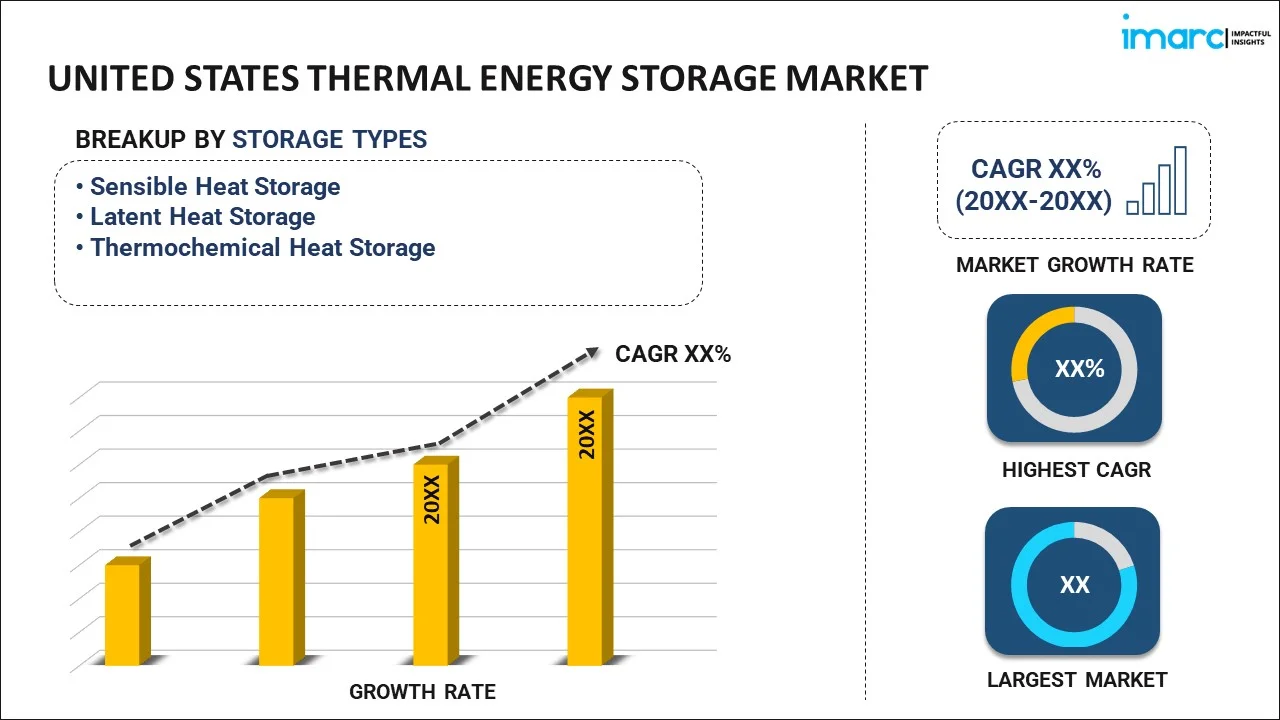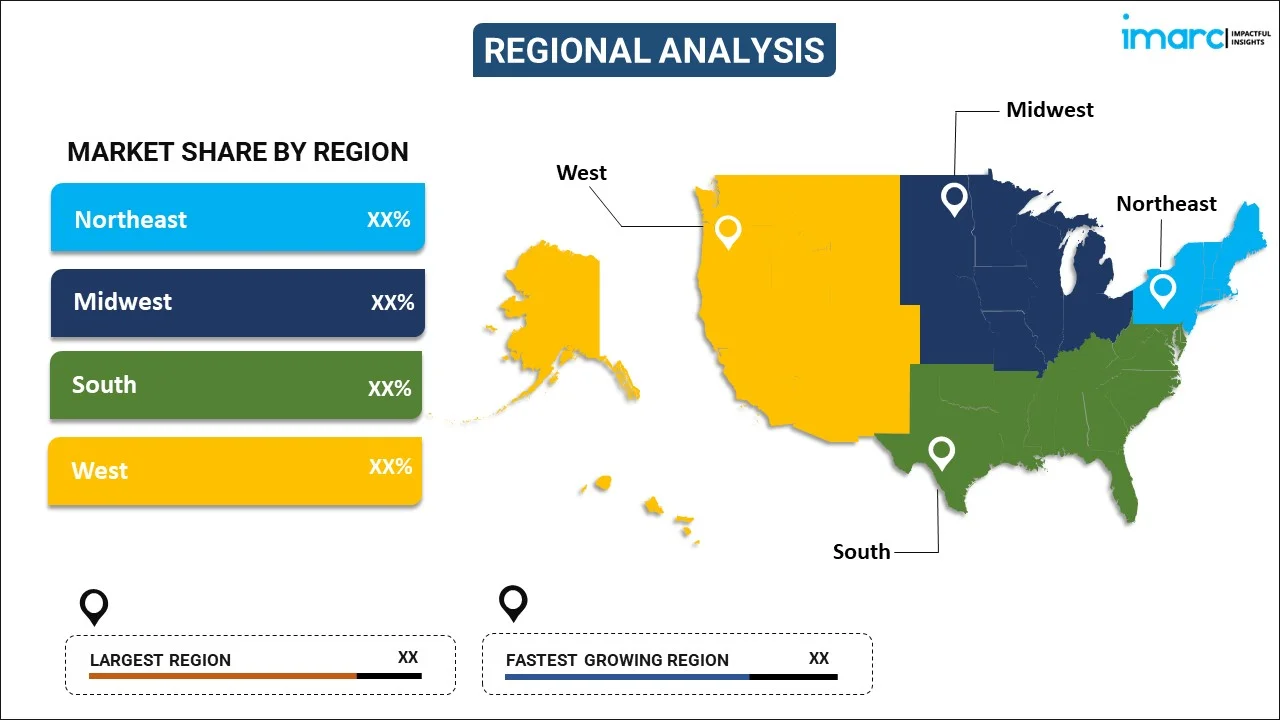
United States Thermal Energy Storage Market Report by Storage Type (Sensible Heat Storage, Latent Heat Storage, Thermochemical Heat Storage), Technology (Molten Salt Technology, Electric Thermal Storage Heaters, Solar Energy Storage, Ice-Based Technology, Miscibility Gap Alloy Technology (MGA), and Others), Material Type (Water, Molten Salt, Phase Change Materials (PCM), and Others), Application (Power Generation, District Heating and Cooling, Process Heating and Cooling), End Use (Residential and Commercial Sector, Utility Industry, and Others), and Region 2025-2033
Market Overview:
United States thermal energy storage market size is projected to exhibit a growth rate (CAGR) of 12.83% during 2025-2033. The increasing adoption of sustainable energy solutions, the escalating need for grid stability, the implementation of government incentives and policies, rising environmental awareness, rapid technological advancements, the expansion of the electric vehicle market, rising energy costs, and the surging demand to reduce carbon emissions are propelling the market growth.
|
Report Attribute
|
Key Statistics
|
|---|---|
|
Base Year
|
2024 |
|
Forecast Years
|
2025-2033 |
|
Historical Years
|
2019-2024
|
| Market Growth Rate (2025-2033) | 12.83% |
Thermal energy storage (TES) is a crucial technology in the field of energy management and sustainability. It is a method of storing thermal energy, primarily in the form of heat, for later use. It is designed to capture excess thermal energy generated during periods of low demand and release it when needed, typically during peak energy demand or when renewable energy sources are not producing energy. TES finds applications in various sectors, including industrial processes, residential heating and cooling, and power generation. In industrial processes, it can help maintain consistent temperatures during manufacturing, improving product quality and energy efficiency. In residential settings, TES systems are used for space heating and cooling, reducing the reliance on fossil fuels or electric heating/cooling, thus contributing to energy savings and reduced greenhouse gas emissions. Moreover, in power generation, it plays a pivotal role in enhancing the efficiency of concentrated solar power plants by storing excess heat and allowing electricity generation during cloudy periods or at night. The advantages of thermal energy storage are significant, such as it enhances energy reliability by providing a buffer during intermittent energy generation, which is particularly valuable with renewable sources like solar and wind. It can also reduce energy costs by allowing industries to use off-peak electricity rates to charge thermal storage units, which can be later used during peak hours when electricity prices are higher.
United States Thermal Energy Storage Market Trends:
The United States thermal energy storage market is influenced by several key drivers, such as the increasing emphasis on sustainable energy solutions, which has driven the adoption of thermal energy storage systems, as they enable the efficient storage of excess energy generated from renewable sources, such as solar and wind. In line with this, the escalating need for grid stability and reliability has led to the integration of thermal energy storage technologies, which can store energy during off-peak hours and release it during peak demand, further fueling the market growth. Additionally, rising energy costs have incentivized industrial and commercial sectors to implement thermal energy storage solutions to manage energy expenses effectively, which is stimulating the market growth. Furthermore, government incentives and policies play a crucial role in driving the thermal energy storage market in the United States. Federal and state-level incentives, such as tax credits and rebates, encourage businesses and homeowners to invest in these technologies, fostering market growth. Moreover, the increasing awareness of environmental concerns and the need to reduce carbon emissions have led to greater interest in thermal energy storage, which is propelling the market growth in the country.
United States Thermal Energy Storage Market Segmentation:
IMARC Group provides an analysis of the key trends in each segment of the market, along with forecasts at the country level for 2025-2033. Our report has categorized the market based on storage type, technology, material type, application, and end use.
Storage Type Insights:

- Sensible Heat Storage
- Latent Heat Storage
- Thermochemical Heat Storage
The report has provided a detailed breakup and analysis of the market based on the storage type. This includes sensible heat storage, latent heat storage, and thermochemical heat storage.
Technology Insights:
- Molten Salt Technology
- Electric Thermal Storage Heaters
- Solar Energy Storage
- Ice-Based Technology
- Miscibility Gap Alloy Technology (MGA)
- Others
A detailed breakup and analysis of the market based on the technology have also been provided in the report. This includes molten salt technology, electric thermal storage heaters, solar energy storage, ice-based technology, miscibility gap alloy technology (MGA), and others.
Material Type Insights:
- Water
- Molten Salt
- Phase Change Materials (PCM)
- Others
The report has provided a detailed breakup and analysis of the market based on the material type. This includes water, molten salt, phase change materials (PCM), and others.
Application Insights:
- Power Generation
- District Heating and Cooling
- Process Heating and Cooling
A detailed breakup and analysis of the market based on the application have also been provided in the report. This includes power generation, district heating and cooling, and process heating and cooling.
End Use Insights:
- Residential and Commercial Sector
- Utility Industry
- Others
The report has provided a detailed breakup and analysis of the market based on the end use. This includes residential and commercial sector, utility industry, and others.
Regional Insights:

- Northeast
- Midwest
- South
- West
The report has also provided a comprehensive analysis of all the major regional markets, which include Northeast, Midwest, South, and West.
Competitive Landscape:
The market research report has also provided a comprehensive analysis of the competitive landscape. Competitive analysis such as market structure, key player positioning, top winning strategies, competitive dashboard, and company evaluation quadrant has been covered in the report. Also, detailed profiles of all major companies have been provided.
United States Thermal Energy Storage Market Report Coverage:
| Report Features | Details |
|---|---|
| Base Year of the Analysis | 2024 |
| Historical Period | 2019-2024 |
| Forecast Period | 2025-2033 |
| Units | Million USD |
| Scope of the Report | Exploration of Historical Trends and Market Outlook, Industry Catalysts and Challenges, Segment-Wise Historical and Future Market Assessment:
|
| Storage Types Covered | Sensible Heat Storage, Latent Heat Storage, Thermochemical Heat Storage |
| Technologies Covered | Molten Salt Technology, Electric Thermal Storage Heaters, Solar Energy Storage, Ice-Based Technology, Miscibility Gap Alloy Technology (MGA), Others |
| Material Types Covered | Water, Molten Salt, Phase Change Materials (PCM), Others |
| Applications Covered | Power Generation, District Heating and Cooling, Process Heating and Cooling |
| End Uses Covered | Residential and Commercial Sector, Utility Industry, Others |
| Regions Covered | Northeast, Midwest, South, West |
| Customization Scope | 10% Free Customization |
| Post-Sale Analyst Support | 10-12 Weeks |
| Delivery Format | PDF and Excel through Email (We can also provide the editable version of the report in PPT/Word format on special request) |
Key Questions Answered in This Report:
- How has the United States thermal energy storage market performed so far and how will it perform in the coming years?
- What has been the impact of COVID-19 on the United States thermal energy storage market?
- What is the breakup of the United States thermal energy storage market on the basis of storage type?
- What is the breakup of the United States thermal energy storage market on the basis of technology?
- What is the breakup of the United States thermal energy storage market on the basis of material type?
- What is the breakup of the United States thermal energy storage market on the basis of application?
- What is the breakup of the United States thermal energy storage market on the basis of end use?
- What are the various stages in the value chain of the United States thermal energy storage market?
- What are the key driving factors and challenges in the United States thermal energy storage?
- What is the structure of the United States thermal energy storage market and who are the key players?
- What is the degree of competition in the United States thermal energy storage market?
Key Benefits for Stakeholders:
- IMARC’s industry report offers a comprehensive quantitative analysis of various market segments, historical and current market trends, market forecasts, and dynamics of the United States thermal energy storage market from 2019-2033.
- The research report provides the latest information on the market drivers, challenges, and opportunities in the United States thermal energy storage market.
- Porter's five forces analysis assist stakeholders in assessing the impact of new entrants, competitive rivalry, supplier power, buyer power, and the threat of substitution. It helps stakeholders to analyze the level of competition within the United States thermal energy storage industry and its attractiveness.
- Competitive landscape allows stakeholders to understand their competitive environment and provides an insight into the current positions of key players in the market.
Need more help?
- Speak to our experienced analysts for insights on the current market scenarios.
- Include additional segments and countries to customize the report as per your requirement.
- Gain an unparalleled competitive advantage in your domain by understanding how to utilize the report and positively impacting your operations and revenue.
- For further assistance, please connect with our analysts.
 Request Customization
Request Customization
 Speak to an Analyst
Speak to an Analyst
 Request Brochure
Request Brochure
 Inquire Before Buying
Inquire Before Buying




.webp)




.webp)












